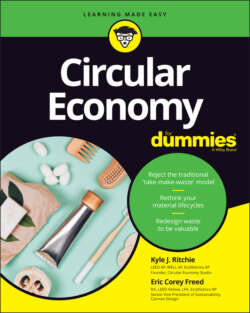Читать книгу Circular Economy For Dummies - Eric Corey Freed - Страница 31
Making biological materials circular
ОглавлениеThe main difference between technical materials and biological materials is that biological materials can be regenerated or grown from the earth. Metals, plastics, and other technical materials are finite and cannot be regenerated. Cotton, timber, and other biological materials can be regenerated, which greatly affects how their lifecycles must be managed within a circular economy. Biological materials can be kept in use for longer periods by allowing the materials themselves to cascade — repurposing from a high-value product to a low-value product. Once the material can no longer serve a function, the biochemical feedstock of that material can be extracted as heat or energy, and the remaining organic material can be utilized as nutrients to fuel the growth of more biological materials.
Cascading keeps biological materials in use for longer periods. Doing so increases the value of that material. For example, rather than cut down a tree and process the fiber to become a piece of paper (low-value product), the tree should be made into something of high-value first, such as a building structure. From there, after it no longer can serve as a building structure, it can cascade into a lower-value product, such as a table or plywood. From there, it can cascade even further to the lowest-value product possible, like a piece of paper. Because a product becomes more valuable the longer it maintains its use, cascading materials acts as a strategy to maximize the value of the biological materials extracted from the earth.
Once that piece of paper has been used, it may seem like waste at this point. It can’t be used as paper again, and it certainly can’t act as a building structure. However, the material itself has an innate value that can be biochemically extracted. Paper can be incinerated to create heat, or the fibers of the paper can be recycled into new paper. Whatever the future of that piece of paper may be, it’s critical to never see it as waste. There is always the embodied value of a material.
Once the material has been fully utilized, the remaining biological content can be directed toward the regeneration of natural systems and the creation of new biological materials. The magical property of biological materials is that they can help grow other materials as a component of compost. Paper pulp can be processed into a nutrient-dense compost to grow more trees, and food waste can be processed to grow more food. When waste is eliminated as a construct, you can start processing materials in a circular manner and waste can be fully eliminated.
Technical materials are materials that cannot be regenerated. They are finite. Biological materials are materials that can be regenerated over and over again. The adjustments made to any material's lifecycle should reflect this critical difference.
Beware of greenwashing, or false claims about a product to convince you that it’s beneficial to the environment.
